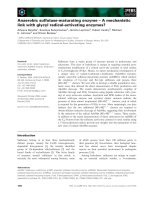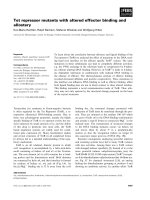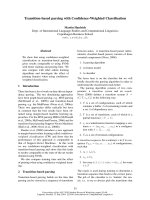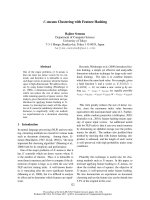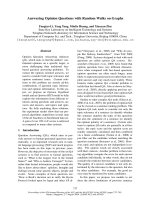Báo cáo khoa hoc:" Retroperitoneoscopic radical nephrectomy with a small incision for renal cell carcinoma: Comparison with the conventional method" docx
Bạn đang xem bản rút gọn của tài liệu. Xem và tải ngay bản đầy đủ của tài liệu tại đây (1.16 MB, 5 trang )
RESEARC H Open Access
Retroperitoneoscopic radical nephrectomy
with a small incision for renal cell carcinoma:
Comparison with the conventional method
Hiroki Ito
*
, Kazuhide Makiyama, Takashi Kawahara, Futoshi Sano, Takayuki Murakami, Narihiko Hayashi,
Yasuhide Miyoshi, Noboru Nakaigawa, Masahiro Yao and Yoshinobu Kubota
Abstract
purpose: When retroperitoneoscopic radical nephrectomy for renal cell carcinoma was introduced into our
institution, we performed a combined small skin incision method. In this method, a small incision was made to
approach the retroperitoneal space prior to setting trockers and thereafter a LAPDISC was placed in the incision to
start the retroperitoneoscopic procedure. In this study, we compared the outcomes between the combined small
skin incision method ("A method” hereinafter) and the conventional method ("B method” hereinafter).
material and methods: Among the cases of T1N0M0 suspicious renal cell carcinoma treated at Yokohama City
University between May 2003 and June 2009, the A method was performed in 51 cases and the B method was
performed in 33 cases. The factors in the outcomes compared betwe en the A and B methods were the duration
of procedure, volume of bleeding, volume of transfusion, weight of the specimen, incidence of peritoneal injury,
rate of conversion to open surgery, and perioperative complications.
results: The duration of the procedure was 214.4 ± 46.9 minutes in the A method group and 208.1 ± 36.4 minutes
in the B method group (p = 0.518). The volume of bleeding and the weight of the specimen were 105.5 ± 283.2
ml and 335.1 ± 137.4 g in the A method group and 44.8 ± 116 ml (p = 0.247) and 309.2 ± 126 g (p = 0.385) in
the B method group. There was no significant difference in all factors analyzed.
conclusion: The A method would be highly possible to produce stable results, even during the introduction
period when the staff and the institution are still unfamiliar with the retroperitoneoscopic surgery.
Keywords: the retroperitoneoscopic radical nephrectomy method with a small incision, surgical outcome
Introduction
The technical progress in laparoscopic surgery f or renal
cell carcinoma has been remarkable. Many institutions
have introduced laparoscopic radical nephrectomy for
renal cell carcinoma and even retroperitoneoscopic radi-
cal nephrectomy for renal cell carcinoma [1]. In recent
years, these surgical methods are in widespread use, and
the number of reports [2,3] about complications asso-
ciated with surgery is rising. It has become important to
identify how such a surgery can be completed in a safe
manner during the introduction period when institutions
and staff are still unfamiliar with these surgical methods.
When retroperitoneoscopic radical nephrectomy for
renal cell ca rcinoma was introduced into our institution,
we performed a combined small skin incision method in
our hospital. That’s because we thought that the combined
small skin incision method was safer than the conven-
tional method that all procedures were performed with
laparoscopic instrumen ts. In this study, we compared the
outcomes between the combined small skin incision
method ("A method” hereinafter) and the conventional
method ("B method” hereinafter).
Material and methods
The surgical procedure of the A method is shown
below. In a lateral position, a lumbar oblique incision
7cmlongismadefromthetopendofthe11
th
rib to
* Correspondence:
Department of Urology, Yokohama City University Graduate School of
Medicine and School of Medicine, Yokohama, Japan
Ito et al. Journal of Negative Results in BioMedicine 2011, 10:11
/>© 2011 It o et al; licensee BioMed Central Ltd. This is an Open Ac cess article distributed under the terms of the Creative Commons
Attribution License ( w hich permits unrestricted use, distribution, and reproduction in
any medium, provided the origin al work is properly cited.
the border of the rectu s abdominis to approach the ret-
roperitoneal space (Figure 1). Under direct vision, the
flank pad was removed through the skin incision with
instruments, not with hands (Figure 2). Subsequently,
the ureter and Gerota’s fascia were dissected from the
peritoneum. After the dissection, hand port device, the
LAPDISC(120 × 120 mm, Hakko, Osaka, Japan), was
attached to the skin and three 12 mm trocars were
placed (Figure 3). The subsequent procedures are per-
formed by retroperitoneoscopic surgery with carbon
dioxide insufflations when the LAPDISC was cloesd. It
was possible to insert forceps through the LAPDISC as
well as to control and operate them (Figure 4). The iso-
lated kidney was removed through the skin incision
[4,5].
Among the cases of suspicious T1N0M0 renal cell carci-
noma treated at Yokohama City University between May
2003 and June 2009, the A method was p erformed in 51
cases (preoperative diagnosis was T1a in 30 cases and T1b
in 21 cases) and the B method was performed in 33 cases
(preoperative diagnosis was T1a in 20 cases and T1b in 13
cases). The A method was performed during the period
between May 2003 and January 2008 and the B method
was performed during the period between Septe mber
2007 and June 2009. The period between September 2007
and January 2008 was a period of transition from the A
method to the B method. During this period, the A
method was performed in 8 cases while the B method was
performed in 5 cases. A total of six surgeons handled
these cases, and the A method was employed by six sur-
geons while the B method was employed by four surgeons.
According to the criteria applied in our hospital for
selecting the surgi cal method for renal cell carcinoma,
the main indication for retroperitoneoscopic radical
nephrectomy for renal cell carcinoma is T1N0M0 renal
cell carcinoma. That’s because we thought that laparo-
scopic approach caused peritoneal adhesion more than
retroperitoneoscopic approach. In T2-T3aN0M0 renal
cell carcinoma as well as in T1 tumours located dorsally,
a laparoscopic approach is preferred. Furthermore, it has
been reported recently that partial nephrectomy for
renal cell carcinoma exhibits higher efficiency [6], and
thus open partial nephrectomy or laparoscopic partial
nephrectomy is more frequently performed in the treat-
ment of T1a renal cell carcinoma in our hospital [7].
The factors in the outcomes compared between the A
and B methods were the duration of procedure, volume
of bleeding, volume of transfusion, weight of the speci-
men, incidence of peritoneal injury, rate of conversion
to laparotomy, and perioperative complications. The
Figure 1 The surgical procedure of the A method (No.1).The
patient’s position is lateral position and an incision of about 7 cm is
made from the top end of the 11
th
rib to the border of the rectus
abdominis.
Figure 2 The surgical procedure of the A method (No.2).Itis
possible to remove the flank pad and to access the retroperitoneal
space under one’s direct vision.
Figure 3 The surgical procedure of the A method (No.3).The
LAPDISC is placed in the incision to insert the port.
Ito et al. Journal of Negative Results in BioMedicine 2011, 10:11
/>Page 2 of 5
Student’s t-test and the Fisher’sexacttestwereusedin
the analysis.
Results
The patients’ backgrounds are as described in Table 1.
The average weight and the average BMI in the A
method cases were 64.6 ± 14.6 kg and 24.3 ± 3.85,
whereas in the B method cases, these were 58.1 ± 12.2
kg (p = 0.0395) and 21. 9 ± 3.58 (p = 0.0055). There was
a difference observed in patients’ backgrounds between
these two groups. However, because the sample cases
had been selected without any intentional action at the
time, it was believed that the difference was accidental.
There was no difference observed in the other factors
(age, male-to-female ratio, body height, and bilateral dif-
ference in tumor location).
Tumor characteristics of all 84 cases are indicated in
Table 2. In the A method, preoperative tumor stage was
T1a in 30 cases and T1b in 21 cases. In the B method,
preoperative tumor stage was T1a in 20 cases a nd T1b
in 13 cases. In the former, pathological tumor stage was
T1a in 37 cases, T1b in 9 cases and larger T2 in 5 cases.
In the latter, pathological tumor stage was T1a in 25
cases, T1b in 5 cases and larger T2 in 3 cases.
Histological data and nuclear grade was available. In
the A method, 84.3% had clear cell tumors, and 15.7%
had other histologies, on the other hand, 78.7% had clear
cell tumors, and 21.3% had other histologies in the B
method. In the former, Pathological nuclear grade was 1
in 29.4%, 2 in 51%, 3 in 13 .7%, and in the latter, t hat
grade was 1 in 24.2%, 2 in 60.6%, 3 in 3%.
In the A metho d group, complications were found in 4
cases: a descending mesocolon injury in 1 case, a renal
vein injury in 1 case, damage to the renal cortex in 1
case, and damage to the inferior surface of the liver in 1
case. In the B method group, complications were found
in 1 case: a renal vein injury in 1 case. Open conversion
was found in 1 case in each group: the case of da mage to
the renal cortex in the A method group and the case of
renal vein injury in the B method group. Blood transfu-
sion was required in 2 cases in the B method group: 1
case of pre-surgery anemia and 1 case of renal vein
injury. Peritoneal injury was identified in 15 cases in the
A method group (29.4%) and 8 cases in the B method
group (24.2%) (p = 0.803).
The duration of the procedure was 214.4 ± 46.9 min-
utes in the A method group and 208.1 ± 36.4 minutes
in the B method group (p = 0.518). The volume of
bleeding and the weight of the specimen were 105.5 ±
283.2 ml and 335.1 ± 137.4 g in the A method group
and 44.8 ± 116 ml (p = 0.247) and 309.2 ± 126 g (p =
0.385) in the B method group. There was no significant
difference in all factors analyzed (Table 3).
Discussion
Retroperitoneoscopic surgery must be performed in a nar-
row operative space and is thus said to be technically diffi-
cult to perform, and therefore laparoscopic surgery was
recommended in the past [8]. However, the invention of
atraumatic balloon dilation has made it easier to secure a
space [8], and retroperitoneoscopic surgery has been in
widespread use in recent years [1]. Many reports have pre-
sented results of a comparison of retroperitoneoscopic
Figure 4 The surgical procedure of the A method (No.4).Itis
possible to insert forceps through the closed LAPDISC as well as to
control and operate them.
Table 1 demographic and tumor data
A method B method p-Value
No. pts 51 33
mean age ± SD 62.55 ± 12.22 60.88 ± 14.46 0.571 *
male-to-female ratio(male/female) 34cases/17cases 22cases/11cases >0.999 *
mean body height ± SD (cm) 162.7 ± 8.9 162.8 ± 11.1 0.952 **
mean body weight ± SD (kg) 64.6 ± 14.6 58.1 ± 12.2 0.0395 **
mean BMI ± SD 24.3 ± 3.85 21.9 ± 3.58 0.0055 **
preoperative tumor diameter ± SD(mm) 40.5 ± 12.6 40 ± 11.7 0.861 *
laterality (left/right) 26/25 16/17 >0.999 *
* Student’s t test ** Fisher’s exact test.
Ito et al. Journal of Negative Results in BioMedicine 2011, 10:11
/>Page 3 of 5
surgery with open surgery and laparoscopic surgery, and
the studies concluded that retroperitoneoscopic radical
nephrectomy is in no way inferior to other traditional sur-
gical methods [9,10]. It is certain that there have been sig-
nificant technical improvements in retroperitoneoscopic
surgery. At the same time, there are also reports on the
existence of learning curves [8]. Tobias-Machado M et. al.
[11] reported t hat a clear learning curve was obtained in
the initial 15 cases.
Inderbir S. Gill et. al. [12] compared the outcomes of
a laparoscopic partial nephrectomy for renal cell carci-
noma soon after introducing it into their institution
with the outcomes of an open laparoscopic partial
nephrectomy for renal cell carcinoma, and reported that
the incidence of intraoperative complications was signif-
icantly higher in laparoscopic surgery. This indicates
that laparoscopic partial nephrectomy for renal cell car-
cinoma is technically difficult to perform. Furtheremore,
however laparoscopic surgery is said to be safer, that
may also induce complications. The complications tend
to be occurred particularly when laparoscopic surgery is
performed during the introduction period when sur-
geons and medical staff are still unfamiliar with this sur-
gical method and when learning curves have not yet
been determined.
Safer laparoscopic surgical methods, such as hand-
assisted laparoscopic surgery, have now been devised [13]
and it has been proved that these methods are less inva-
sive than open surgery. The A method was similar to this
hand-assisted laparoscopic surgery. But the A method
could be better than hond-assited method in terms of
being able to using abdominal air pressure to prevent
bleedeing. The A method was performed at the time of
introduction of retroperitoneoscopic surgery into our
institution and it was possible to obtain stable results.
One of the advantages of the A method could be safety.
Since it is possible to remove the flank pad and to access
the retroperitoneal space under one’s direct vision, it is
easier to understand the orientation, and it is possible to
more promptly facilitate open conversion in cases of
massive bleeding. However, the open conversion in 1
case of the A method was not emergent but selective. So,
we were fortunately not given an opportunity to perform
it in order to stop massive bleeding.
On the other hand, one of the disadvantages of the A
method is larger size of the incision. The incision, which is
about 7 cm, is larger than the approximately 5 cm incision
in the traditional methods, and the preceding incision lim-
its port sites. In particular, limits of port sites were more
prominent with thinner patients and disturbed the surgical
procedures in quite a few cases.
In this study, there was no difference in surgical out-
comes between the A method and the B method for
renal cell carcinoma. Since there was no difference in the
outcomes between the A method at the time of introduc-
tion of retroperitoneoscopic surgery and the B method
when the staff had become familiar with retroperitoneo-
scopic surgery, it was indicated that the A method could
be safer. In addition, we had to state that we have limita-
tions in this study because of small sample size included.
Such a small number of sample included in this study
might be related to a lack of statistical power. That could
induce no difference between the two groups in surgical
outcomes.
Conclusion
This study identified no large differences in the out-
comes between the retroperitoneoscopic radical
nephrectomy method with a small incision for renal cell
carcinoma and the standard method.
Table 2 clinical T stage and pahological data
A method B method
preoperative clinical T stage T1a 30 (59%) 20 (61%)
T1b 21 (41%) 13 (39%)
pathological classification clear cell 43 (84%) 26 (79%)
Papillary 3 (6%) 0
Chromophobe 2 (4%) 3 (9%)
benign 2 (4%) 2 (6%)
Other 1 (2%) 2 (6%)
grade G1 15 (29%) 8 (24%)
G2 26 (51%) 20 (61%)
G3 7 (14%) 1 (3%)
Unclear 3 (6%) 4 (12%)
microscopic venous invasion Negative 38 (75%) 18 (55%)
Positive 13 (26%) 11 (33%)
Unclear 0 4 (12%)
pathological T stage T1a 37 (73%) 25 (76%)
T1b 9 (18%) 5 (15%)
T2- 5 (10%) 3 (9%)
* Student’s t test ** Fisher’s exact test.
Table 3 intraoperative and postoperative parameters
between A method and B method
A method B method p-
Value
mean operative time ± SD
(min)
214.4 ± 46.9 208.1 ± 36.4 0.518 **
blood loss ± SD (ml) 105.5 ± 283.2 44.8 ± 116 0.247 **
blood transfusion ± SD (unit) 0 0.242 ± 1.09 0.115 **
weight of specimens ± SD (g) 335.1 ± 137.4 309.2 ± 126 0.385 **
peritoneal injury 15cases
(29.4%)
8cases
(24.2%)
0.803 *
complications 4cases (7.8%) 1cases
(3.03%)
0.644 *
open conversion 1cases (1.96%) 1cases
(3.03%)
>0.999
*
* Student’s t test ** Fisher’s exact test.
Ito et al. Journal of Negative Results in BioMedicine 2011, 10:11
/>Page 4 of 5
It would be highly possible to produce stable results,
even during the introductionperiodwhenthestaffand
the institution are still unfamiliar with the retroperito-
neoscopicsurgery,byapplyingtheprocedureofacom-
bined small skin incision.
Abbreviations
A method: Retroperitoneoscopic radical nephrectomy with a small incision;
B method: Standard way of retroperitoneoscopic radical nephrectomy.
Authors’ contributions
All authors participated in the design and conduct of the study. All authors
reviewed and approved the final version of the manuscript.
Competing interests
The authors declare that they have no competing interests.
Received: 13 January 2011 Accepted: 16 August 2011
Published: 16 August 2011
References
1. Hollingsworth JM, Miller DC, Dunn RL, Montgomery JS, Roberts WW,
Hafez KS, Wolf JS Jr: Surgical management of low-stage renal cell
carcinoma: Technology does not supersede biology. Urology 2006,
67(6):1175-80.
2. Liapis D, de la Taille A, Ploussard G, Robert G, Bastien L, Hoznek A,
Vordos D, Abbou C, Salomon L: Analysis of complications from 600
retroperitoneoscopic procedures of the upper urinary tract during the
last 10 years. World J Urol 2008, 26(6):523-30.
3. Pareek G, Hedican SP, Gee JR, Bruskewitz RC, Nakada SY: Meta-analysis of
the complications of laparoscopic renal surgery: comparison of
procedures and techniques. J Urol 2006, 175:1208-13.
4. Makiyama K, Fujinami K, Suzuki K, Sugiura S, Teranishi J, Sano F, Saito K,
Noguchi K, Kubota Y: Safe retroperitoneoscopic radical nephrectomy with
small incision for renal cell carcinoma. Nippon Hinyokika Gakkai Zasshi
2004, 95(4):669-74.
5. Makiyama K, Nakaigawa N, Miyoshi Y, Kubota Y, Suzuki K, Kishida K,
Noguchi K, Kitami K, Kobayashi K, Moriyama M: Retroperitoneoscopic
radical nephrectomy with small incision for renal cell carcinoma
-Learning curve and complications Jpn J Endourol ESWL 2006, 19:82-86.
6. Fergany AF, Hafez KS, Novick AC: Long-term results of nephron sparing
surgery for localized renal cell carcinoma:10-year followup. J Urol 2000,
163(2):442-5.
7. Makiyama K, Nakaigawa N, Miyoshi Y, Murakami T, Ogawa T, Uemura H,
Yao M, Kubota Y: Laparoscopic surgery for renal cell carcinoma in view
of QOL. Hinyoukigeka 2007, 20(Rinzou):497-499.
8. Gill IS, Schweizer D, Hobart MG, Sung GT, Klein EA, Novick AC:
Retroperitoneal laparoscopic radical nephrectomy: the Cleveland clinic
experience. J Urol 2000, 163:1665-70.
9. Desai MM, Strzempkowski B, Matin SF, Steinberg AP, Ng C, Meraney AM,
Kaouk JH, Gill IS: Prospective randomized comparison of transperitoneal
versus retroperitoneal laparoscopic radical nephrectomy. J Urol 2005,
173(1):38-41.
10. Gratzke C, Seitz M, Bayrle F, Schlenker B, Bastian PJ, Haseke N, Bader M,
Tilki D, Roosen A, Karl A, Reich O, Khoder WY, Wyler S, Stief CG, Staehler M,
Bachmann A: Quality of life and perioperative outcomes after
retroperitoneoscopic radical nephrectomy (RN), open RN and nephron-
sparing surgery in patients with renal cell carcinoma. BJU Int 2009,
104(4):470-5.
11. Tobias-Machado M, Ravizzini PI, Pertusier LO, Pedroso E, Wroclawski ER:
Prospective comparative study between retroperitoneoscopic and hand-
assisted laparoscopic approach for radical nephrectomy. Int Braz J Urol
2009, 35(3):284-91, discussion 291-2.
12. Gill IS, Matin SF, Desai MM, Kaouk JH, Steinberg A, Mascha E, Thornton J,
Sherief MH, Strzempkowski B, Novick AC: Comparative analysis of
laparoscopic versus open partial nephrectomy for renal tumors in 200
patients. J Urol 2003, 170(1):64-8.
13. Tanaka M, Tokuda N, Koga H, Yokomizo A, Sakamoto N, Naito S: Hand
assisted laparoscopic radical nephrectomy for renal carcinoma using a
new abdominal wall sealing device. J Urol 2000, 164(2):314-8.
doi:10.1186/1477-5751-10-11
Cite this article as: Ito et al.: Retroperitoneoscopic radical nephrectomy
with a small incision for renal cell carcinoma: Comparison with the
conventional method. Journal of Negative Results in BioMedicine 2011
10:11.
Submit your next manuscript to BioMed Central
and take full advantage of:
• Convenient online submission
• Thorough peer review
• No space constraints or color figure charges
• Immediate publication on acceptance
• Inclusion in PubMed, CAS, Scopus and Google Scholar
• Research which is freely available for redistribution
Submit your manuscript at
www.biomedcentral.com/submit
Ito et al. Journal of Negative Results in BioMedicine 2011, 10:11
/>Page 5 of 5
